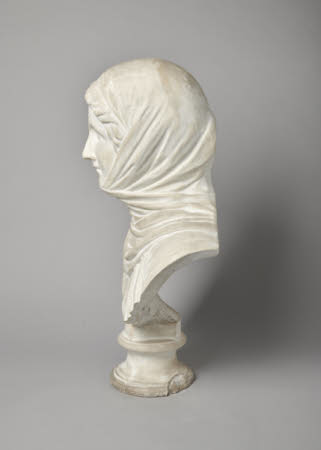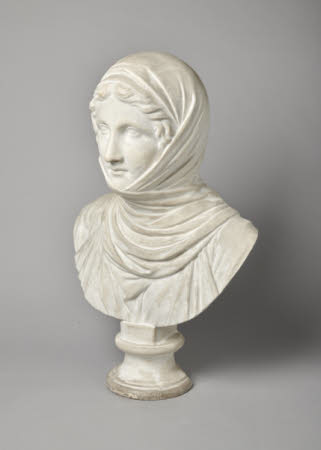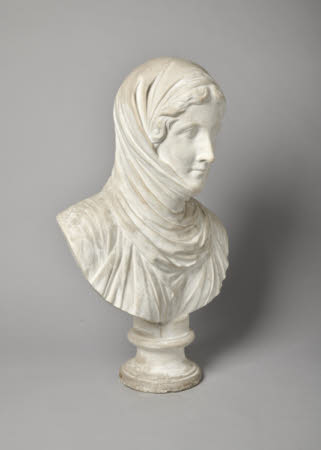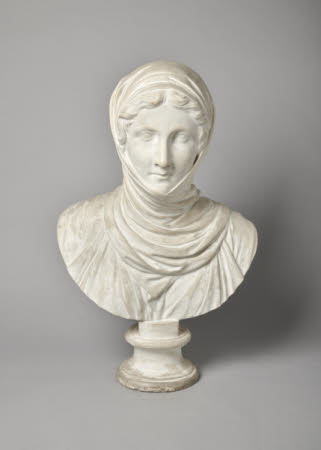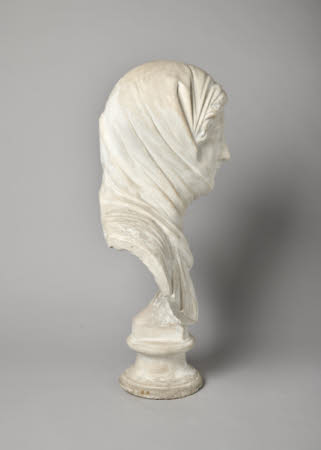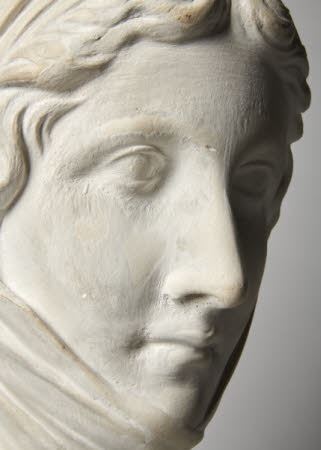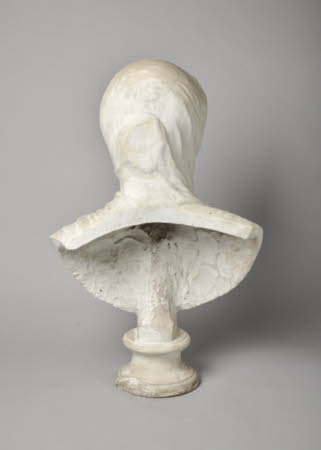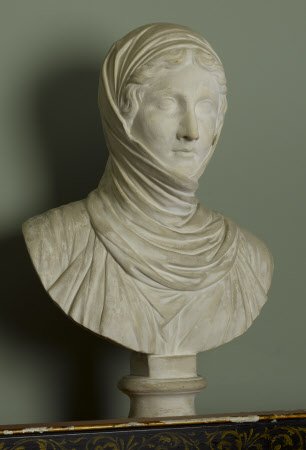Head of a woman, formerly known as a Vestal Virgin or the Zingarella
Unknown
Category
Art / Sculpture
Date
c. 1750 - 1800
Materials
Plaster
Measurements
642 x 521 x 419 mm
Place of origin
Britain or Ireland
Order this imageCollection
Mount Stewart, County Down
NT 1220125.2
Summary
Sculpture, plaster; Portrait bust of a woman, known as a Vestal Virgin or as the Zingarella, after an antique model; probably British or Irish; c. 1750-1800. A plaster copy of a Hellenistic marble head now in the Museo Archeologico Nazionale in Naples, formerly identified as a Vestal Virgin, and otherwise popularly known as the Zingarella (‘Gipsy Girl’). The bust was formerly thought to be a portrait of Mary Cowan, Mrs Alexander Stewart (1713–1788).
Full description
A plaster head of a young woman, looking ahead, hair parted in the middle, wearing a tunic and over her head the top of a mantle, known as an ampechonion, tightly wrapped around her head and her neck. Rounded bust section. On an integral socle. Break in foot of socle, towards the back. The bust is a copy of a once-celebrated Hellenistic marble bust from the Farnese collection, now in the Museo Archeologico Nazionale in Naples (Inv. 6194; Gasparri 2009, I, pp. 203-205, no. 95 (Stefania Pafumi); Omar Cucciniello and Paola Zatti, eds., Canova. I volti ideali, exh. cat., Galleria d’arte Moderna, Milan 2019, pp. 160-61, no. 3.1). Probably acquired by the Farnese family in the sixteenth century, the head was first certainly recorded in an inventory of Palazzo Farnese in Rome in 1644. The sculpture was much admired by visitors to Rome in the seventeenth and eighteenth centuries, the British traveller Edward Wright for example describing it as ‘a Vestal Virgin of exquisite beauty’ (Wright 1730, I, p. 285). The German classical art historian Johann Joachim Winkelmann (1717-68) questioned whether the traditional identification of the sculpture as a Vestal Virgin, a Roman priestess, was in fact correct. It has also been popularly known as La Zingarella (‘the gipsy girl’) because of its generic resemblance to two restored antique sculptures of women from the Borghese collection, one now in the Musée du Louvre in Paris (on deposit at Versailles) and the other still in the Galleria Borghese in Rome. Both have bronze heads and other additions attributed to the French sculptor Nicolas Cordier (1567-1612), who worked in Rome, and have long been popularly known as the Zingara (‘the gipsy woman’). The sculpture now in Naples was restored in 1786 in the workshop of Carlo Albacini, before it was transferred with the remainder of the Farnese collections from Rome to Naples. The head was much copied in the eighteenth century and seems to have enjoyed special popularity with the British and Irish. An early eighteenth-century drawing, in the Topham collection at Eton College (Inv. Bm7.7), suggests that Albacini’s restorations were minimal. There are marble copies at Arddress (NT 247725.1) and at Stourhead (NT 732909), both currently attributed to Christopher Hewetson (1737-98), the Irish sculptor who worked in Rome for most of his career. A plaster copy is at West Wycombe Park (NT 807688.1). Other copies are at Broadlands (Dagmar Grassinger, Antike Marmorskulpturen auf Schloß Broadlands (Hampshire), Mainz am Rhein 1994, pp. 106-07, no. 106-07, no. 34) and at Lydiard Park, Swindon (Inv. LYD1993-90-1), where it is attributed to John Cheere (1709-87). Both the Stourhead and West Wycombe heads are paired with a head of the Zingara, based on Cordier’s sculpture at Versailles. It is by no means clear that Cheere did make copies of the Farnese bust, and certainly the great majority of eighteenth-century copies of the Zingara made in England by him and by Peter Scheemakers (1691-1781) appear to have been after the Cordier model, rather than the head in Naples. It is not possible to know with any certainty where the plaster cast at Mount Stewart was made, but it is most probable that it was produced in a workshop in Britain or Ireland. In the early nineteenth century, the head in Naples enjoyed renewed popularity, when it inspired Antonio Canova (1757-1822) to make a series of similar heads of Vestals (Omar Cucciniello and Paola Zatti, nos. 3.4-3.6). Jeremy Warren June 2022
Provenance
On loan to the National Trust from Lady Mairi Bury (1921-2009) from 1976; accepted by HM Government in lieu of Inheritance Tax and allocated to the National Trust in 2013.
Makers and roles
Unknown, sculptor
References
Wright, Edward, Esq. Some observations made in travelling through France, Italy, &c. in the years 1720, 1721, and 1722. M.DCC.XXX. [1730]., I, p. 285. Gasparri 2009: Carlo Gasparri, ed., Le sculture Farnese, 3 vols., Milan 2009., I, pp. 203-205, no. 95.
